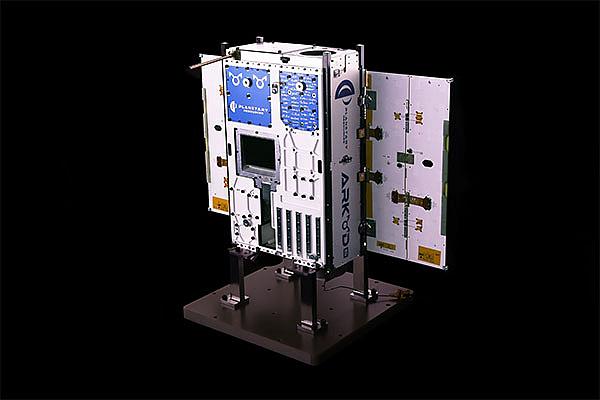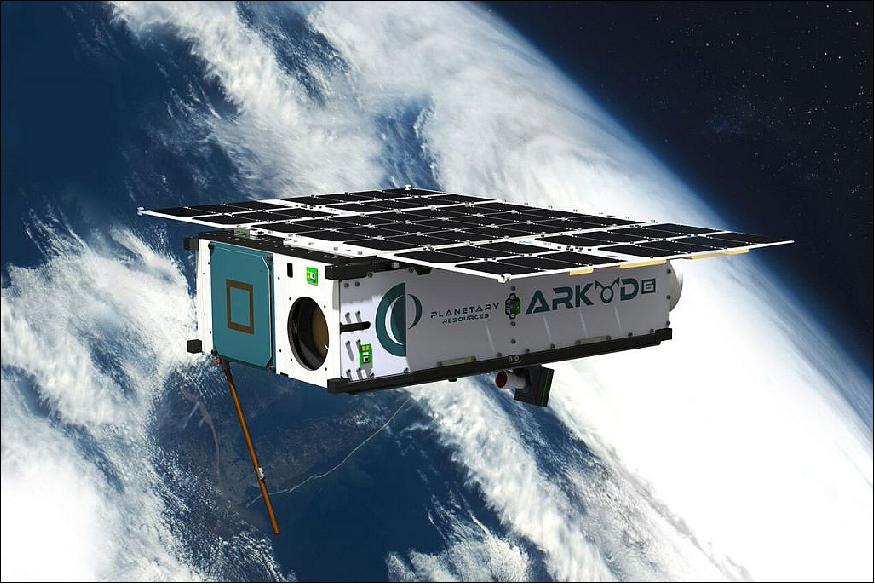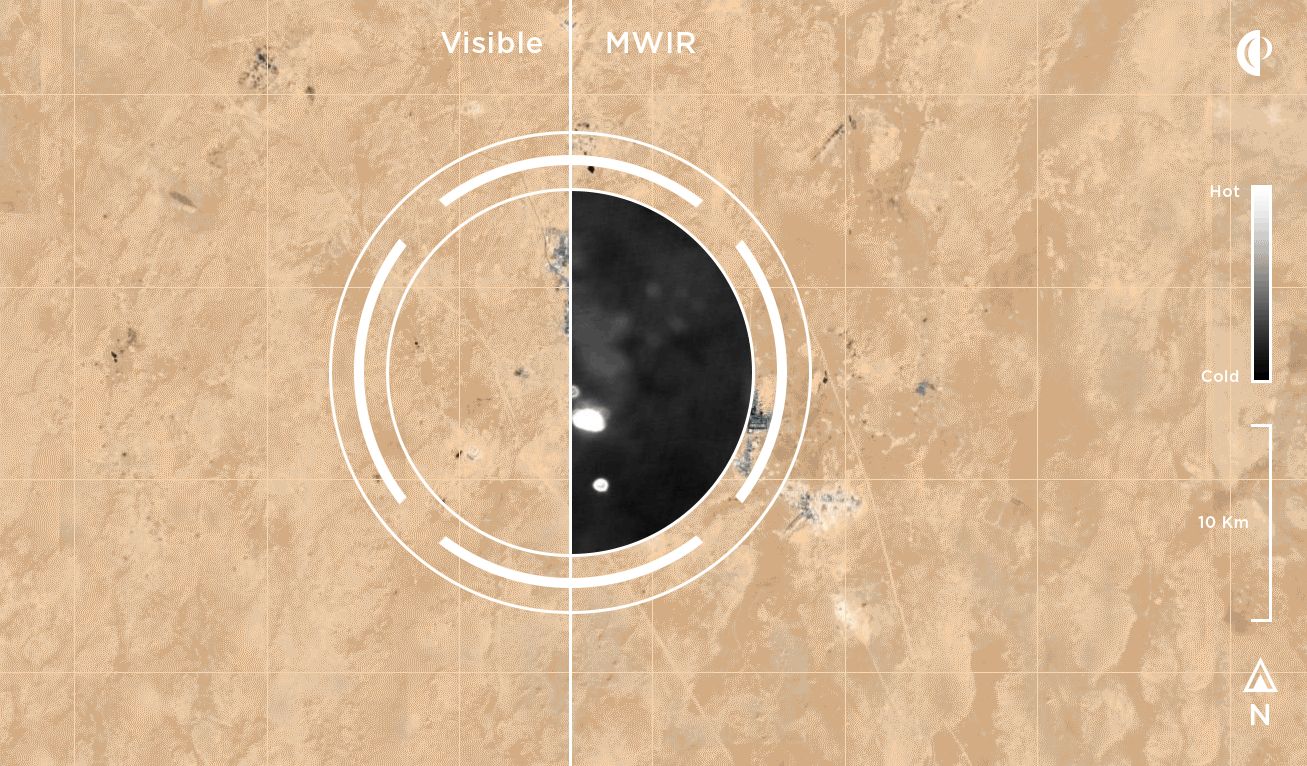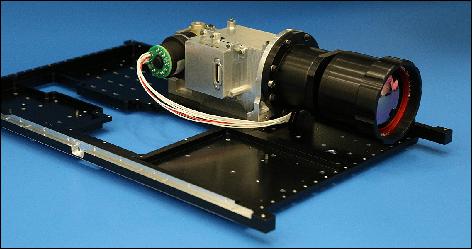Arkyd-6 CubeSat
Non-EO
Mission complete
ISRO
Technology and Research
Quick facts
Overview
| Mission type | Non-EO |
| Agency | ISRO |
| Mission status | Mission complete |
| Launch date | 12 Jan 2018 |
| End of life date | 26 Apr 2018 |
Arkyd-6
Spacecraft Launch Mission Status Sensor Complement References
Arkyd-6 is a 6U CubeSat technology demonstration mission of Planetary Resources Inc. with the goal to explore potentially useful resources on asteroids and develop technologies for asteroid mining. A long-term strategic plan was developed by the company to first test their technologies in Earth orbit with small satellite missions, then upgrading to LEO-based space telescopes to study asteroids and eventually sending probes to asteroids to survey and exploit the resources they may offer.
Planetary Resources is embarking on the world's first commercial deep space exploration program. The purpose is to identify and unlock the critical water resources necessary for human expansion in space.
Sourcing water is the first step to creating a civilization in space. Water is used for life support functions and can also be refined into rocket propellant. The initial mission will identify the asteroids that contain the best source of water, and will simultaneously provide the vital information needed to build a commercial mine which will harvest water for use in space. 1)
Background
Planetary resources of Redmond WA, formerly known as Arkyd Astronautics, is an American company that was founded in January 2009 by Eric Anderson, Dr. Peter H. Diamandis and Chris Lewicki, and reorganized and renamed in 2012. Its stated goal is to "expand Earth's natural resource base" by developing and deploying the technologies for asteroid mining. Planetary Resources is financed by industry-launching visionaries who are committed to expanding the world's resource base so humanity can continue to grow and prosper for centuries to come. Some of the company's partners and advisors include the Government of Luxembourg's SpaceResources.lu initiative, 3D Systems, the Bechtel Corporation, Analytical Graphics Incorporated, etc. 2)
Planetary Resources aims to be the leading provider of resources for people and products in deep space through its goal of identifying, extracting, and refining resources from near-Earth asteroids. The company's first technology demonstration satellite, the Arkyd-3, launched from Cape Canaveral with SpaceX flight CRS-6 in April 2015, and deployed from the International Space Station. Arkyd-3 was deployed from the ISS on 16 July 2015 to begin flight testing. Arkyd-3 reentered the atmosphere on 23 December 2015.
Also, the company successfully lobbied towards the passage of the U.S. Commercial Space Launch Competitiveness Act (H.R. 2262) which recognizes the right of U.S. citizens to own asteroid resources they obtain and encourages the commercial exploration and utilization of resources from asteroids. In 2016, the company announced a partnership with the Government of Luxembourg to advance the space resources industry and in 2017, Luxembourg's Chamber of Deputies passed a law recognizing the right to space-based resources. In 2018, the company launched the Arkyd-6 containing a demonstration of technology designed to detect water resources in space and has completed the world's first deep space resource exploration plan to characterize hydrated resources on near-Earth asteroids. 3)
A long-term strategic plan was developed by the company to first test their technologies in Earth orbit with small satellite missions, then upgrading to LEO-based space telescopes to study asteroids and eventually sending probes to asteroids to survey and exploit the resources they may offer.
Spacecraft
Built in compliance with the 6U CubeSat standard, the Arkyd-6 satellite includes the core technology that will be used in the company's asteroid exploration program including a mid-wave infrared sensor, second-generation avionics, power systems, communications, and attitude determination and control systems. The nanosatellite is 30 x 20 x 10 cm in size with a mass of ~ 10 kg.
The Arkyd-6 builds on the capabilities of the Arkyd-3 by taking advantage of the added mass and volume for additional payload and instrument accommodation. The Arkyd-6 spacecraft demonstrates core internal system elements developed in-house, including avionics, flight software, restraint and deployment devices, star trackers, reaction wheels, power generation, power management, and energy storage elements.
The second-generation systems will allow for precision pointing via star-trackers and incorporate a high degree of autonomy as would be required for a mission to distant destinations. According to Planet Resources, over 90% of hardware on the Arkyd-6 platform was developed and built in-house. The communications system marks a major step up from the Arkyd-3 satellite that only used a 115 kbit/s S-band terminal. Arkyd-6 features a low-rate UHF system operating at 40 kbit/s for command uplink and telemetry downlink, an S-band uplink at 500 kbit/s and an X-band downlink at 6 Mbit/s to handle payload data generated by the MWIR imaging instrument. Arkyd-6 hosts a body-mounted and two deployable solar arrays delivering an orbit average power of 35 W.
TCS (Thermal Control Subsystem): The modular nature of avionics allows for scalable thermal control of the spacecraft. Thermal design, simulation, and test are all completed in-house. Thermal coatings and blanket implementations are also done internally.

The Arkyd-100 and Arkyd-200 spacecraft, currently in design, continue the evolution of spacecraft development and maturation, building the platform to a full scientific remote sensing system capable of leaving orbit and exploring deep space.
If all goes according to plan, the company will launch multiple Arkyd-301 spacecraft atop a single rocket in 2020. Each spacecraft will cruise to a different asteroid, then assess the space rock's resource potential using onboard instruments such as the MWIR imager. The Arkyd-301s will also carry piggyback miniprobes, which will deploy from their motherships and burrow into their target asteroid to get even closer looks at the space rocks.
Launch
Arkyd-6 was launched as a secondary payload on 12 January 2018 (03:59 UTC) on the PSLV-40 flight vehicle (XL configuration) of ISRO. The launch site was the SDSC (Satish Dhawan Space Center) SHAR (Sriharikota) on the east coast of India. The primary payload on this flight was CartoSat-2F (formerly CartoSat-2ER) of ISRO with a mass of 710 kg. 4) 5)
Orbit: Sun-synchronous orbit with an altitude of 505 km and an inclination of 97.55º.
Secondary Payloads
The co-passenger satellites comprise one microsatellite and one nanosatellite from India as well as one minisatellite plus 2 microsatellites and 25 nanosatellites from six countries, namely, Canada, Finland, France, Republic of Korea, UK and USA. The total mass of all the 31 satellites carried onboard PSLV-C40 is about 1323 kg.
The 28 international customer satellites are being launched as part of the commercial arrangements between Antrix Corporation Limited (Antrix), a Government of India company under Department of Space (DOS), the commercial arm of ISRO and the International customers.
Out of the 31 satellites, 23 were integrated on the rocket (and subsequently successfully deployed into orbit) using the ISISpace' QuadPack CubeSat deployers and relied on the ISISpace sequencing electronics for the timely deployment. With the success of this campaign, ISIS (Innovative Solutions In Space) of Delft, The Netherlands, has reached a total of 256 satellites sent to space and 197 QuadPack doors successfully opened.
• TeleSat LEO Phase 1, a communications minisatellite mission (168 kg) of Telesat Canada, built by SSTL, Surrey, UK.
• Carbonite-2, a microsatellite (~100 kg) of SSTL (X50 platform) to demonstrate video performance for the future Earth-i Vivid-i constellation. Earth-i is located at Surrey Research Park, Guildford, UK.
• IITMSAT [IIT (Indian Institute of Technology) Madras Satellite], also referred to as INS-1C, a student built microsatellite (11 kg) to study the energy spectrum of charged particles in the upper ionosphere.
• Microsat of ISRO in the 100 kg class, that derives its heritage from IMS-1 bus. This is a technology demonstrator and the forerunner for future satellites of this series. The satellite bus is modular in design and can be fabricated and tested independently of payload. 6)
• PicSat, a 3U CubeSat (3.5 kg) of the Paris Observatory, France. PicSat is an astronomy mission to measure exoplanetary transits.
• CANYVAL-X, 1, 2, a technology demonstration CubeSat mission (1U and 2U CubeSats) of Korea's Yonsei University and KARI (Korea Aerospace Research Institute) in collaboration with NASA; the goal is to demonstrate a Vision Alignment System.
• CNUSail-1 (Chungnam National University Sail-1), a 3U CubeSat solar sail test of Chungnam National University, Korea (4 kg).
• KAUSAT-5 (Korea Aviation University Satellite), a 3U CubeSat (4 kg) to observe the Earth with an IR camera and measure the amount of radiation around LEO.
• SIGMA (Scientific cubesat with Instruments for Global magnetic field and rAdiation) or KHUSAT-3 (Kyung Hee University Satellite-3), a 3U CubeSat to measure the global magnetic field and radiation.
• STEP CubeLab (Space Technology Experimental Project CubeSat Laboratory), a 1U CubeSat of Chosun University, Gwangju, Korea. The objective is to exploit core space technologies researched by domestic universities and verify the effectiveness of these technologies through on-orbit tests using the CubeSat.
• ICEYE-X1, Finland's SAR (Synthetic Aperture Radar) microsatellite with a mas of <100 kg.
• CICERO-7, a 6U CubeSat (~10 kg) of GeoOptics, USA, built by Tyvak, to demonstrate radio occultation observations.
• Arkyd-6, a 6U CubeSat of Planetary Resources Inc., USA (formerly Arkyd Astronautics) to test attitude control, power, and communication systems as well as a photo-display-and-retransmission system.
• Fox-1D, a radio amateur and technology research 1U CubeSat, developed by AMSAT, USA and hosting several university developed payloads (University of Iowa, Virginia Tech, and Pennsylvania State-Erie).
• Lemur-2 x 4, 3U CubeSats of Spire Global Inc., San Francisco, CA.
• Landmapper-BC3 (Corvus-BC3), a 6U CubeSat (10 kg) of Astro Digital (former Aquila Space), USA to provide multispectral imagery of 22 m resolution on a swath of 220 km.
• MicroMAS-2a, a 3U CubeSat mission (3.8 kg) of MIT/LL (Massachusetts Institute of Technology/Lincoln Laboratory) of Lexington, MA, USA. Test of a compact microwave spectrometer and radiometer payload in orbit.
• SpaceBEE x 4 picosatellites, built to 0.25 CubeSat form factor, a technology demonstration, USA
• Flock-3p x 4, 3U CubeSats of Planet, San Francisco, USA.
• Tyvak 61C, a 3U CubeSat and a technology demonstration and astronomy mission of Tyvak Inc., Irvine CA, USA.

Mission Status
• April 26, 2018: Planetary Resources is reporting that the Arkyd-6 satellite has satisfied all of the mission requirements. The spacecraft successfully demonstrated the distributed computing system, communications, attitude control system, power generation and storage with deployable solar arrays and batteries, star tracker and reaction wheels as well as the first, commercial MWIR (Mid-Wave Infrared) imager operated in space on a nanosatellite. 7)

Legend to Figure 3: Arkyd-6 is a part of Planetary Resources' research and development work to create an instrument capable of detecting water on near-Earth asteroids. The data obtained from this mission, along with the experience gained from building and operating the Arkyd-6 will assist in the development of the Arkyd-301, our next spacecraft platform.
• In the weeks following launch, the Planetary Resources team worked tirelessly in Redmond managing the mission. Even though the spacecraft was fully autonomous and able to execute all functions independently, it communicated with our team at every critical check point (Ref. 7).
• January 12, 2018: The PSLV-40 flight vehicle successfully deployed all satellites from seven countries into orbit.
Sensor Complement
MWIR (Mid-Wave Infrared) Imager
MWIR features a spectral range of 3.4-5.1 µm that has proven a sensitive method for detecting water and mapping thermal energy. From its orbital altitude of 500 km, Arkyd-6 achieves a fairly high ground resolution of 26 m for an MWIR instrument. The MWIR instrument has a volume of 1.5U and uses a 200 mm focal-length telescopic imager feeding a 640 x 512-pixel Indium-Antimonide detector array that is cooled to 77 K with a Sterling cryocooler. The instrument captures imagery of a 19 x 15 km ground footprint.

References
1) "Asteroid mining is the key to our future expansion into space," Planetary Resources, 30 Nov. 2017, URL: https://www.planetaryresources.com/2017/11/asteroid
mining-is-the-key-to-our-future-expansion-into-space/
2) "Planetary Resources," URL: https://en.wikipedia.org/wiki/Planetary_Resources
3) "Timeline," Planetary Resources, 2018, URL: https://www.planetaryresources.com/company/timeline/
4) "PSLV Successfully Launches 31 Satellites in a Single Flight," ISRO, 12 Jan. 2018, URL: https://www.isro.gov.in/2018press15.html
5) Stephen Clark, "India's PSLV lifts off on first flight since fairing failure," Spaceflight Now, 12 January 2018, URL: https://spaceflightnow.com/2018/01/12/pslv-c-40-coverage/
6) "Microsat," ISRO, 12 Jan. 2018, URL: https://web.archive.org/web/20220812014734/https://www.isro.gov.in/Spacecraft/microsat-0
7) Chris Lewicki, "Mission Success: Arkyd-6 tests key technologies for commercial space resource exploration," Planetary Resources, 24 April 2018, URL: https://www.planetaryresources.com/2018/04/mission-success-arkyd-6-tests-key-technologies-for-commercial-space-resource-exploration/
The information compiled and edited in this article was provided by Herbert J. Kramer from his documentation of: "Observation of the Earth and Its Environment: Survey of Missions and Sensors" (Springer Verlag) as well as many other sources after the publication of the 4th edition in 2002. - Comments and corrections to this article are always welcome for further updates (eoportal@symbios.space).
Spacecraft Launch Mission Status Sensor Complement References Back to top